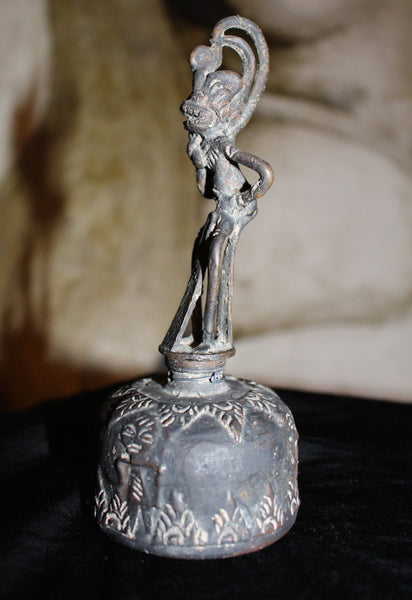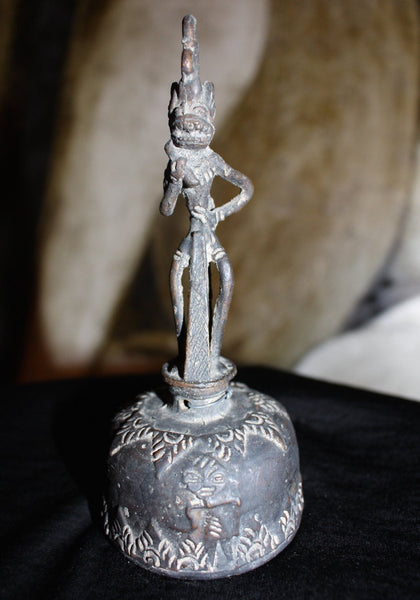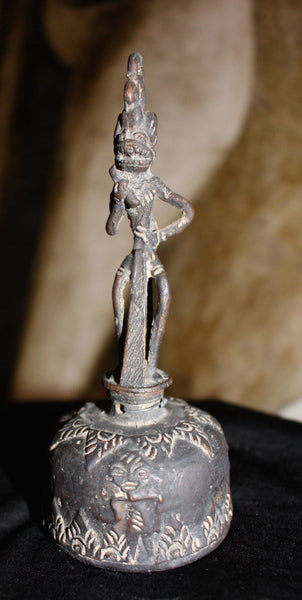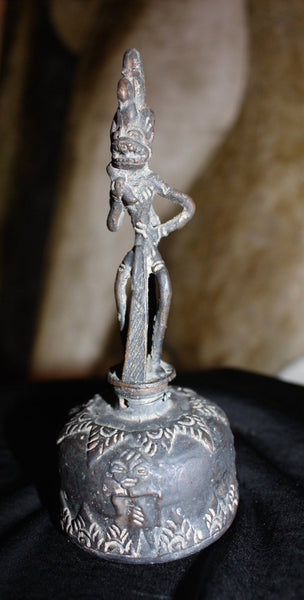Benin Bronze King Oba Antique Nigerian Region West African Royal Ancestral Altar Bell Ethnographic Oceanic Tribal Ritual Artifact Sculpture
Held in private collection, the condition of this bell remains unchanged from the time of its original later 1940's field acquisition. Original phallic shaped clapper continues to produce clear strong notes with a delightful tonal quality. This royal Benin altar bell would have been used solely by the Oba as decreed by the figural representation of the Oba himself as the handle. Later royal descendants may have also used the piece on an ancestral altar, provided they were in succession to the throne. Exhibits the tell tale ever-so-slight traces of oily residue precisely w human hands would have held the piece. Iconography, refined metal content, clean lines, heavier weight, and Portuguese faces are indicative of the early second period and serve to verify the age of this spectacular, museum quality find.
Chronology:
As a result of the abrupt and violent manner in which most royal art forms of the kingdom of Benin were removed from their original context by the British in 1897, it is a dearth of documentation to situate individual works historically. This has led art historians to propose stylistic theories concerning their chronological execution. The current accepted theory is that the smallest and most naturalistic objects are the earliest, with a gradual progression toward increased size and degree of stylization. Between 1500 and 1800, the Benin kingdom gradually grew in both wealth and power, primarily through extensive trade with the Portuguese. In the arts, this expansion is manifested in a dramatic increase in the size and ostentation of royal regalia. Crowns of Edo kings grew steadily more encrusted with coral beading and this appears to have been reflected in changes in commemorative representations as well. Additionally, the largess of royal patronage decreased artisans' incentive to be judicious with expensive materials, allowing them to create ever-larger objects. Tfore, in the attempt to construct a chronology for Benin art, it makes sense that later castings would be both heavier and larger objects that conspicuously consumed greater quantities of imported brass and emphasized the more elaborate regalia.
The earliest commemorative heads have light thin walls and a tight-fitting collar that does not cover the chin. They have no beaded crown. The next or second period includes heads that are larger and heavier. The beaded collar reaches the mouth, with the addition of bead clusters to the crown. The head is far more stylized and has a wide and cylindrical shape; additionally, the cheeks appear swollen and the eyes are enlarged. In the third period, the flange is expanded and the features are further exaggerated. T are winglike projections on the crowns, which are thought to represent the ceremonial swords of the court. T are also representations of beads that hang in front of the eyes.
History
Bells comprised one of the most widespread art forms in southern Nigeria, serving military, ceremonial, religious, and musical functions. Used as portable noisemakers to announce a sacred presence and neutralize hostile forces.
Collected from the: Benin Kingdom of Nigeria, West Africa
Material: Bronze, old lost wax casting of copper/tin alloy, skin oil
Nigerian African Tribal Ancient Artifact Cast Bronze Alloy Ceremonial
Period: 17th century, conservatively
Dimensions: 6" height" x 2" at base
Exquisite Condition: Near pristine - no damage, anticipated minute casting imperfections typical of the early lost wax process. Iconography, fine metal content, tool signatures, and superior casting quality all indicate the early second period of production.
Contact Us:
pacificfineart@gmail.com
424-259-3290









